G. Henle Musikverlag Piano Music
- p.1 (Al - Ba)
- p.2 (Ba - Ba)
- p.3 (Ba - Be)
- p.4 (Be - Br)
- p.5 (Br - Ch)
- p.6 (Ch - De)
- p.7 (De - Ha)
- p.8 (Ha - Li)
- p.9 (Li - Mo)
- p.10 (Mo - Sa)
- p.11 (Sa - Sc)
- p.12 (Sc - Sc)
- p.13 (Sc - We)
- Next >
-
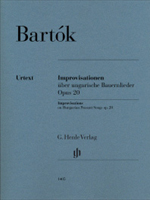
-
Bartok, Bela
Improvisation on Hungarian Peasant Songs, op 20 (Somfai/Varjon)
After his 15 Hungarian Peasant Songs, these Improvisations on Hungarian peasant songs are the second of Bartok's works to feature the words "Hungarian peasant songs" in their title. The manner in which he confronts folk melodies with subtle, avant-garde sounds here was later described by Bart˘k himself as venturing to "the outermost limits." He also breaks up the song structures so radically into their constituent motives that the title "improvisations" best conveys his approach to this folk musi...
Read More
Category: Piano Solos
Item: 120253
Grade:
Price: $15.95
Availability: Ships in 10 to 15 Days - View Shopping Cart
-
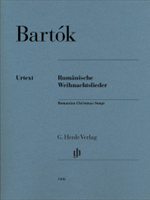
-
Bartok, Bela
Romanian Christmas Songs (Somfai)
Bartok's Romanian Christmas Carols are based on folk melodies that originated in a pagan celebration of the winter solstice, and which he felt gave "the impression of a fiery, war-like type of song, rather than a pious and religious one." Nevertheless, he chose 20 melodies from this collection of "colinde" and published them under the title of "Christmas Carols." In the first edition of 1918 they were conceived for children's hands and so were published "without octaves"; but in his revised editi...
Read More
Category: Piano Solos
Item: 120252
Grade:
Price: $18.95
Availability: Usually Ships in 24 Hours - View Shopping Cart
-
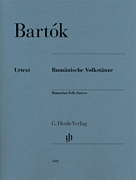
-
Bartok, Bela
Romanian Folk Dances, sz.56 (Somfai)
20th Century. Bartok's Romanian Folk Dances, composed in 1915, are among his best-known works. They exist in multiple forms, since as well as several piano arrangements and a later orchestral version of his own there also exist arrangements by his contemporaries that were made with his consent. Today we can even access performances of the dances by Bart˘k himself; these recordings document varied repeats enriched by octave doublings to make a sort of "concert version" of the dances. Bart˘k expert...
Read More
Category: Piano Composer Folios
Item: 116161
Grade:
Price: $14.95
Availability: Ships in 10 to 15 Days - View Shopping Cart
-
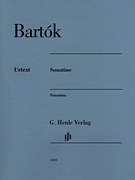
-
Bartok, Bela
Sonatine (Somfai)
Category: Piano Solos
Item: 113108
Grade:
Price: $11.95
Availability: Ships in 10 to 15 Days - View Shopping Cart
-
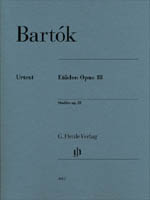
-
Bartok, Bela
Studies, op 18 (Somfai)
With these three studies Bartok quite deliberately aimed to leave his mark on New Music in 1918. The first study is a kind of super-charged, motorically vehement Allegro barbaro, while the second, with its effervescent waterfalls of sound, seems redolentof an elegy inspired by Debussy. In the third, by contrast, Schonberg's influence is recognisable. The latter's "Private Musical Performances" in Vienna were also among the few occasions in the 1920s where Bartok's supremely demanding cycle - for ...
Read More
Category: Piano Composer Folios
Item: 128678
Grade:
Price: $15.95
Availability: Ships in 10 to 15 Days - View Shopping Cart
-
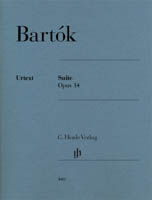
-
Bartok, Bela
Suite, op 14 (Somfai)
The four-movement Suite op. 14 was composed in 1916 and was one of Bartok's favourite piano works throughout his life. Unlike in his other works for piano of these years, he did not use any folksong melodies or folkloristic elements here. Instead, he endeavoured to achieve a new, more "abstract", transparent piano style that forgoes ornament and embellishment. A special feature of this Henle edition is the appendix with an additional Andante movement that was originally intended to come before th...
Read More
Category: Piano Solos
Item: 124719
Grade:
Price: $15.95
Availability: Ships in 10 to 15 Days - View Shopping Cart
-

-
Beattie
Easy Solos & Duets (10)
Category: Piano Composer Folios
Item: 025152
Grade:
Price: $7.95
Availability: Ships in 6 to 9 Days - View Shopping Cart
-
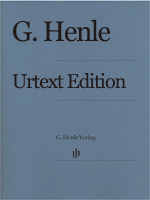
-
Beethoven, Ludwig Van
Andante in F, WoO 57
G. Henle URTEXT edition
Category: Piano Solos
Item: 013761
Grade:
Price: $12.95
Availability: Ships in 6 to 9 Days - View Shopping Cart
-
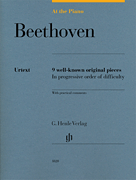
-
Beethoven, Ludwig Van
At the Piano (Hewig-Troescher)
9 Well-Known Original Pieces in Progressive Order of Difficulty. Contents: • Lustig-Traurig, WoO 54 • Six Eccossaises, WoO 83 • Bagatelle in A minor, WwO 59 "Fr Elise" • Piano Sonata No. 20 in G Major, Op. 49, No. 2 • Adagio sostenuto from Piano Sonata No. 14 in C-sharp minor, Op. 27, No. 2 "Moonlight" • Marcia Funebre sulla morte d'un Eroe from Piano Sonata No. 12 in A-flat Major, Op. 26 • Piano Sonata No...
Read More
Category: Piano Composer Folios
Item: 115429
Grade:
Price: $19.95
Availability: Ships in 10 to 15 Days - View Shopping Cart
-

-
Beethoven, Ludwig Van
Bagatelles (7), op 33 (Biermann & Koenen)
For a long time it was assumed that Beethoven reworked seven older pieces for his op. 33, published in 1803. But in the meantime it has been determined that all the surviving sketches came into being in 1801/02, and that the autograph dates from 1802. The fact that the composer wrote such bagatelles for amateurs in temporal proximity to the demanding Piano Sonatas op. 31 may at first glance be unsettling. But the pieces, in simple dance and song forms, display remarkable refinement. The collectio...
Read More
Category: Piano Solos
Item: 138140
Grade: Advanced
Price: $13.95
Availability: Usually Ships in 24 Hours - View Shopping Cart
-
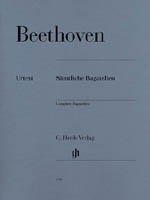
-
Beethoven, Ludwig Van
Bagatelles, Complete (Von Irmer)
G. Henle URTEXT edition. Includes opus 33, opus 119, op 126, plus without opus 52 and 56. Whenever one speaks about Beethoven's piano music, it is usually his sonatas that come to mind. However, his other works for this instrument are of no less significance. Thus it is not a coincidence that Beethoven published the majority of his Bagatellenwith an opus number, as this went hand in hand with a certain regard for the pieces in question: they represent Beethoven's lighter, more accessible side, d...
Read More
Category: Piano Composer Folios
Item: 001900
Grade:
Price: $25.95
Availability: Usually Ships in 24 Hours - View Shopping Cart
-
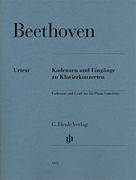
-
Beethoven, Ludwig Van
Cadenzas & Lead-Ins for Piano Concertos (Loesti/Schilde)
Classical/Romantic. Contains all of Beethoven's surviving cadenzas and lead-ins for piano concertos: both for his own concertos nos. 1-4, for his piano arrangement of the Violin Concerto opus 61 as well as for Mozart's Concerto in D minor K. 466. Based on the musical text of the Beethoven Complete Edition.
Category: Piano Composer Folios
Item: 096342
Grade:
Price: $29.95
Availability: Usually Ships in 24 Hours - View Shopping Cart
-

-
Beethoven, Ludwig Van
Complete Dances
G. Henle URTEXT edition. Contains: 12 German Dances WoO 13; 12 German Dances WoO 8; 12 Minuets WoO 7; ;6 "Lndlerische" Dances WoO 15; 6 Ecossaises WoO 83; 6 Minuets WoO 10; 7 "Lndlerische" Dances WoO 11; Allemande A major WoO 81; Appendix: 7 Contra Dances from WoO 14; Ecossaise E flat major WoO 86; Minuet E flat major WoO 82; Waltz D major WoO 85; Waltz E flat major WoO 84. (thematic index & sample pages) ...
Read More
Category: Piano Composer Folios
Item: 003649
Grade:
Price: $27.95
Availability: Ships in 6 to 9 Days - View Shopping Cart
-

-
Beethoven, Ludwig Van
Concerto in D, op 61a, after Violin Concerto (Kuthen, et al)
Edited by Hans-Werner Kuthen. Fingering by Klaus Schilde. Piano reduction by Jurgen Sommer. Cadenzas by the composer.
Category: Piano Solos
Item: 058759
Grade:
Price: $44.95
Availability: Usually Ships in 24 Hours - View Shopping Cart
-

-
Beethoven, Ludwig Van
Concerto in Eb, op 27, no 1 (Wallner/Hansen)
G. Henle URTEXT edition. Edited by Bertha Antonia Wallner. Fingering by Conrad Hansen.
Category: Piano Solos
Item: 043648
Grade:
Price: $9.95
Availability: Ships in 6 to 9 Days - View Shopping Cart
-
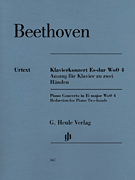
-
Beethoven, Ludwig Van
Concerto in Eb, WoO 4 - solo part (Kuethen/Schilde)
Romantic. Following the musical text of the Beethoven Complete Edition, Piano Concerto in E-flat Major WoO 4 can now be performed in its surviving form - by a pianist without an orchestra. -the publisher
Category: Piano Solos
Item: 097479
Grade:
Price: $19.95
Availability: Ships in 6 to 9 Days - View Shopping Cart
-

-
Beethoven, Ludwig Van
Diabelli Variations, op 120 (Kross/Georgii)
G. Henle URTEXT edition. Edited by Siegfried Kross. Fingering by Walter Georgii.
Category: Piano Solos
Item: 028313
Grade:
Price: $16.95
Availability: Ships in 6 to 9 Days - View Shopping Cart
-
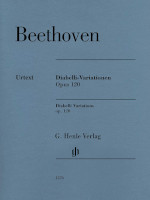
-
Beethoven, Ludwig Van
Diabelli Variations, op 120 (Loy/Fountain)
Romantic. Beethoven's "33 Variations on a waltz by A. Diabelli," composed between 1819 and 1823, are his most significant contribution to the genre. The notice announcing the publication of the first edition aptly claimed that "These are no variations ofthe usual kind but a great and important masterpiece." The Viennese publisher Anton Diabelli had asked 50 composers to write one variation each on his waltz, for publication in an anthology. But instead, Beethoven used it for a comprehensive explo...
Read More
Category: Piano Composer Folios
Item: 124998
Grade:
Price: $20.95
Availability: Ships in 10 to 15 Days - View Shopping Cart
-
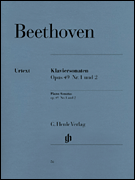
-
Beethoven, Ludwig Van
Easy Sonatas (2), op 49 (Wallner)
Romantic. The opus number of Beethoven's Easy Piano Sonatas op. 49 is misleading. The pieces were written not long after the Sonatas op. 2, and most likely - in part, at least - before his Sonata op. 7. Sketches can be found in the "Kafka Miscellany" sketchbook, which Beethoven used for several years both in Bonn and subsequently in Vienna until the late 1790s. The second sonata seems to be the earlier of the two. The composer also reprised the theme of the second movement, Tempo di Menuetto, for...
Read More
Category: Piano Composer Folios
Item: 013774
Grade:
Price: $8.95
Availability: Ships in 6 to 9 Days - View Shopping Cart
-
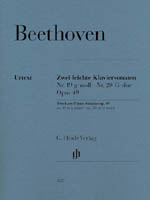
-
Beethoven, Ludwig Van
Easy Sonatas (2), op 49 (Gertsch/Perahia)
Romantic. The two piano sonatas op. 49, described in their first publication as "Sonates faciles", are often the first-ever Beethoven sonatas with which advanced piano pupils can demonstrate their ability. Their relatively high opus number is misleading,however, for both these two-movement works were composed at roughly the same time as the piano sonatas op. 10, between 1796 and 1798. The fact that they were actually published seven years later is presumably thanks to the business dealings of Bee...
Read More
Category: Piano Composer Folios
Item: 124366
Grade:
Price: $9.95
Availability: Ships in 10 to 15 Days - View Shopping Cart
-
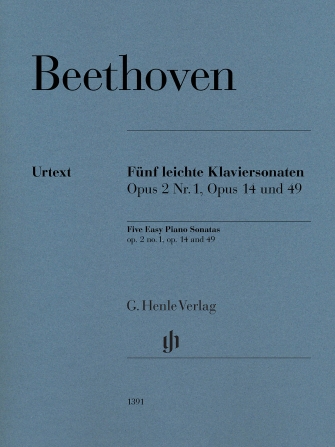
-
Beethoven, Ludwig Van
Easy Sonatas (5) (Gertsch/Perahia)
Romantic. This selection of five "easy" sonatas offers advanced students of piano and aficionados the perfect entry point into the singular world of this great composer's piano sonatas. Arranged in increasing level of difficulty, this volume features allthe benefits of the new Urtext edition, prepared by maestro Murray Perahia and the Beethoven expert Nobert Gertsch: an extensive preface on the genesis and publication of the works, comprehensive source information and the discussion of problemati...
Read More
Category: Piano Composer Folios
Item: 125190
Grade:
Price: $22.95
Availability: Ships in 10 to 15 Days - View Shopping Cart
-

-
Beethoven, Ludwig Van
Ecossaises, WoO 83 & 86
G. Henle URTEXT edition.
Category: Piano Composer Folios
Item: 006809
Grade:
Price: $7.95
Availability: Ships in 6 to 9 Days - View Shopping Cart
-

-
Beethoven, Ludwig Van
Egmont Stage Music, op 84
G. Henle URTEXT edition.
Category: Piano Solos
Item: 031605
Grade:
Price: $22.95
Availability: Usually Ships in 24 Hours - View Shopping Cart
-
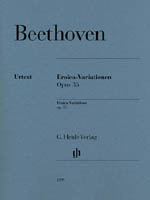
-
Beethoven, Ludwig Van
Eroica Variations, op 35 (Loy/Fountain)
Romantic. The Fifteen Variations (with Fugue) op. 35 composed in 1802 are known primarily by their sobriquet "Eroica Variations" because the theme is also used in the finale of the Third Symphony. Together with its sister work, opus 34, this composition marks the breakthrough of character variations. Not without pride did the composer stress to his publisher that both works were "arranged in a truly quite new fashion." For the first time ever, the Eroica Variations are available in a standalone e...
Read More
Category: Piano Solos
Item: 124364
Grade:
Price: $10.95
Availability: Ships in 10 to 15 Days - View Shopping Cart
-
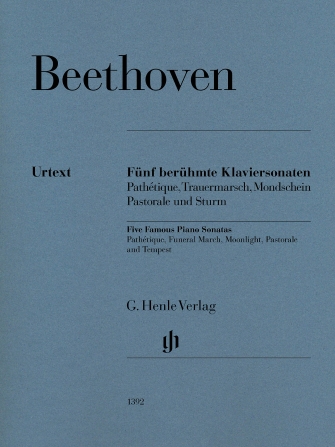
-
Beethoven, Ludwig Van
Famous Piano Sonatas (5) (Gertsch/Perahia)
Romantic. Five famous sonatas by Beethoven - all bearing a popular epithet known the world over - are presented to advanced pianists in this attractive volume of selected works from the new three-volume Urtext edition. These five pieces do not all numberamong the most difficult sonatas from Beethoven's cosmos but do indeed demand an advanced keyboard technique. They reveal to every Beethoven enthusiast the multifarious spectrum of these impassioned compositions from his quill. This collection als...
Read More
Category: Piano Composer Folios
Item: 125191
Grade:
Price: $27.95
Availability: Ships in 10 to 15 Days - View Shopping Cart
-

-
Beethoven, Ludwig Van
Fantasie for Piano, Choir & Orchestra, op 80 (Schulze & Raab)
Henle urtext edition
Category: Piano Solos
Item: 043420
Grade: Advanced
Price: $24.95
Availability: Ships in 6 to 9 Days - View Shopping Cart
-
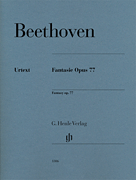
-
Beethoven, Ludwig Van
Fantasy in Gm, op 77 (Irmer)
Category: Piano Solos
Item: 112401
Grade:
Price: $9.95
Availability: Ships in 10 to 15 Days - View Shopping Cart
-
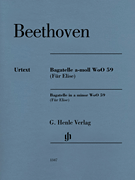
-
Beethoven, Ludwig Van
Fur Elise [Bagatelle in Am, w/oo 59] (Koenen/Biermann)
There are probably very few piano students who have not tried their hand at this piece; it is undeniably one of the most popular classical piano pieces today. And yet unanswered questions still remain. They not only concern details in the musical text but also its famous nickname: Is "Elise", the reading in the dedication in the autograph, even actually correct? Or should it read "Therese"? And whom might Beethoven have actually meant? The most recent findings with regard to these questions are d...
Read More
Category: Piano Solos
Item: 112528
Grade:
Price: $4.95
Availability: Ships in 10 to 15 Days - View Shopping Cart
-

-
Beethoven, Ludwig Van
Piano Pieces [Klavierstuecke] (Irmer)
G. Henle URTEXT edition. This inexhaustible collection of Beethoven's piano works is highly recommended to players who wish to gain deepr insight into Beethoven's musical development. It contains all of Beethoven's piano compositions except for the 32 sonatas, the variations and the dances, and thus presents works from all stages of this great composer's life. Included are his endearing Bagatelles op. 33, the album leaf "Fr Elise," "The Rage over a Lost Penny," and the three "Kurfrsten" Sonatas...
Read More
Category: Piano Composer Folios
Item: 001874
Grade:
Price: $44.95
Availability: Ships in 6 to 9 Days - View Shopping Cart
-
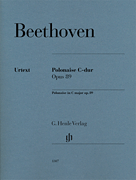
-
Beethoven, Ludwig Van
Polonaise in C, op 89 (Irmer)
Category: Piano Solos
Item: 112400
Grade:
Price: $8.95
Availability: Usually Ships in 24 Hours - View Shopping Cart
-

-
Beethoven, Ludwig Van
Rage Over a Lost Penny, op 129 [Alla Ingharese]
G. Henle URTEXT edition of Alla Ingharese quasi un Capriccio [Rage over the last penny].
Category: Piano Solos
Item: 013817
Grade:
Price: $8.95
Availability: Ships in 6 to 9 Days - View Shopping Cart
-

-
Beethoven, Ludwig Van
Rage Over a Lost Penny, op 129 [Alla Ingharese] (Biermann/Zhang)
This rondo for piano was composed in 1794/95 and has become known primarily by its sobriquet "The rage over the lost penny". However, this did not originate with the composer himself, but rather added to the autograph later by another hand. In his own original title, Beethoven emphasised its "Hungarian" style, though he wrote "Ingharese" instead of "allungharese," thereby emphasising the humorous nature of this spirited piece. Robert Schumann aptly remarked that "There can hardly be anything more...
Read More
Category: Piano Solos
Item: 135858
Grade: Advanced
Price: $9.95
Availability: Ships in 10 to 15 Days - View Shopping Cart
-

-
Beethoven, Ludwig Van
Rondo in Bb, Woo 6 (Kuethen/Umbreit/Groethuysen)
Category: Piano Solos
Item: 094252
Grade:
Price: $24.95
Availability: Ships in 6 to 9 Days - View Shopping Cart
-

-
Beethoven, Ludwig Van
Rondo in C, op 51
G. Henle URTEXT edition
Category: Piano Solos
Item: 013810
Grade:
Price: $8.95
Availability: Ships in 6 to 9 Days - View Shopping Cart
-
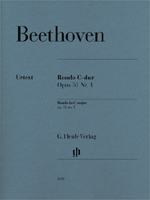
-
Beethoven, Ludwig Van
Rondo in C, op 51, no 1 (Biermann)
The two Rondos op. 51 were written independently of one another and only later consolidated into a single opus by Beethoven's publisher. The first of these works from 1797 quickly became popular on account of how it combines simple, catchy melody with surprising modulations and expressive, dramatic eruptions within a compact form. With its moderate degree of difficulty, the piece is ideal preparation before embarking on Beethoven's piano sonatas. Based on her preliminary research for the critical...
Read More
Category: Piano Solos
Item: 129367
Grade:
Price: $9.95
Availability: Usually Ships in 24 Hours - View Shopping Cart
-
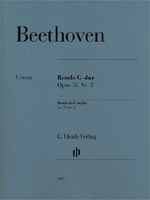
-
Beethoven, Ludwig Van
Rondo in G, op 51, no 2 (Biermann)
This composition published in 1802 constitutes a completely separate concert piece from Opus 51 no. 1. Compared to the first Rondo (op. 51 no. 1), the second is considerably longer and with a markedly different expressive disposition. Here, lyrical traits predominate without any of the dramatic incursions otherwise so emblematic of Beethoven's compositions. For that reason, this comparatively reserved work did not enjoy the same popularity as the Rondo op. 51 no. 1 and continues to invite redisco...
Read More
Category: Piano Solos
Item: 129266
Grade:
Price: $10.95
Availability: Usually Ships in 24 Hours - View Shopping Cart
-

-
Beethoven, Ludwig Van
Sonata No 1 in Fm, op 2, no 1 (Gertsch/Perahia)
Beethoven's three piano sonatas op. 2 were the first works in this genre to which he gave an opus number, thus signalling to the musical world the special importance that he assigned to them. He wrote them during his first years in Vienna and, along withhis op. 1 piano trios, they helped to establish his reputation as one of the most significant composers of his time. These three sonatas- all of them small masterpieces - are arranged in ascending order of difficulty and virtuosity. The four-movem...
Read More
Category: Piano Solos
Item: 119734
Grade:
Price: $12.95
Availability: Ships in 10 to 15 Days - View Shopping Cart
-
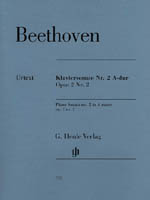
-
Beethoven, Ludwig Van
Sonata No 2 in A, op 2, no 2 (Gertsch/Perahia)
Classical. Beethoven's three piano sonatas op. 2 were the first works in this genre to which he gave an opus number, thus signaling to the music world the special importance that he assigned to them. He wrote them during his first years in Vienna and, along with his op. 1 piano trios, they helped to establish his reputation as one of the most significant composers of his time. These three sonatas - all of them small masterpieces - are arranged in ascending order of difficulty and virtuosity. At t...
Read More
Category: Piano Solos
Item: 123674
Grade:
Price: $12.95
Availability: Usually Ships in 24 Hours - View Shopping Cart
-
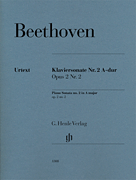
-
Beethoven, Ludwig Van
Sonata No 2 in A, op 2, no 2 (Wallner)
Category: Piano Solos
Item: 112399
Grade:
Price: $12.95
Availability: Usually Ships in 24 Hours - View Shopping Cart
-
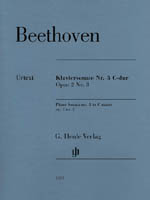
-
Beethoven, Ludwig Van
Sonata No 3 in C, op 2, no 3 (Gerlach/Perahia)
Classical. Beethoven's three Piano sonatas op. 2 were the first works in this genre to which he gave an opus number, thus signalling to the music world the special importance that he assigned to them. He wrote them during his first years in Vienna and, along with his op. 1 piano trios op. 1, they helped to establish his reputation as one of the most significant composers of his time. These three sonatas - all of them small masterpieces - are arranged in ascending order of difficulty and virtuosit...
Read More
Category: Piano Solos
Item: 130513
Grade:
Price: $15.95
Availability: Usually Ships in 24 Hours - View Shopping Cart
-
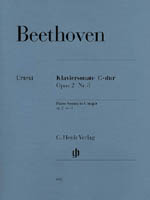
-
Beethoven, Ludwig Van
Sonata No 3 in C, op 2, no 3 (Wallner)
Ludwig van Beethoven's three sonatas Op. 2 stand at the beginning of his oeuvre, but there is absolutely nothing tentative or "early" about them. Not a note could be changed; strict logic rules every movement. Five years after Mozart's death, a new genius emerged here. The Sonata in C Major Op. 2, No. 3 from 1795 is large and brilliant, more expansive than the two other sonatas of Oop. 2, and created for virtuoso effect. Its key of C Major already has the celebratory, victorious sound of the "Wal...
Read More
Category: Piano Solos
Item: 029282
Grade:
Price: $16.95
Availability: Ships in 6 to 9 Days - View Shopping Cart
-

-
Beethoven, Ludwig Van
Sonata No 4 in Eb, op 7 (Gertsch/Perahia)
Category: Piano Solos
Item: 091732
Grade:
Price: $11.95
Availability: Ships in 6 to 9 Days - View Shopping Cart
-

-
Beethoven, Ludwig Van
Sonata No 5 in Cm, op 10, no 1
G. Henle URTEXT edition
Category: Piano Solos
Item: 013769
Grade:
Price: $8.95
Availability: Usually Ships in 24 Hours - View Shopping Cart
-
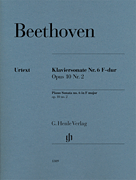
-
Beethoven, Ludwig Van
Sonata No 6 in F, op 10, no 2 (Wallner/Hansen)
Category: Piano Solos
Item: 112642
Grade:
Price: $8.95
Availability: Usually Ships in 24 Hours - View Shopping Cart
-

-
Beethoven, Ludwig Van
Sonata No 7 in D, op 10, no 3 (Gertsch/Perahia)
Beethoven's Piano Sonata no. 7 in D major is the third from his Opus 10, which appeared in 1798, and simultaneously the heavyweight of this group of works. As one of the most powerful sonatas from the early years, it captivates with its very broad spectrum of moods and highly elaborate interplay of motivic elements. At the centre is the famous Largo e mesto, mournful, plaintive and almost tragic in the profundity of its emotion. It is framed by an energetic first movement and a nimble Menuetto. T...
Read More
Category: Piano Solos
Item: 135893
Grade: Advanced
Price: $12.95
Availability: Usually Ships in 24 Hours - View Shopping Cart
-

-
Beethoven, Ludwig Van
Sonata No 7 in D, op 10, no 3
G. Henle URTEXT edition.
Category: Piano Solos
Item: 030229
Grade:
Price: $11.95
Availability: Usually Ships in 24 Hours - View Shopping Cart
-
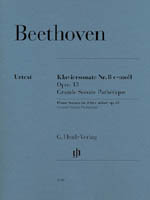
-
Beethoven, Ludwig Van
Sonata No 8 in Cm, op 13 - Grande Sonata Pathetique (Gertsch/Perahia)
Classical. In a span of only eight years, between 1794-1802, Beethoven composed twenty piano sonatas, among them his so-called "Grande sonate pathtique" op. 13. It marks the consummation of his Classical style, yet also already alludes to his Heroic Period with its intensely Romantic characteristics. Composed in the "tragic" key of C minor, it foreshadows the expressive drama of later masterworks such as the Fifth Symphony or the Coriolan Overture. Of the famous sonatas, this one is the most tec...
Read More
Category: Piano Solos
Item: 124367
Grade:
Price: $10.95
Availability: Ships in 10 to 15 Days - View Shopping Cart
-

-
Beethoven, Ludwig van
Sonata No 11 B Major, op 22 (Gertsch/Perahia)
Category: Piano Solos
Item: 133815
Grade: Advanced
Price: $12.95
Availability: Usually Ships in 24 Hours - View Shopping Cart
-
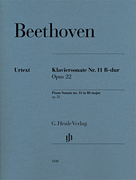
-
Beethoven, Ludwig Van
Sonata No 11 in Bb, op 22 (Wallner/Hansen)
Category: Piano Solos
Item: 112643
Grade:
Price: $12.95
Availability: Ships in 10 to 15 Days - View Shopping Cart
-

-
Beethoven, Ludwig Van
Sonata No 12 in Ab, op 26
G. Henle URTEXT edition.
Category: Piano Solos
Item: 037351
Grade:
Price: $14.95
Availability: Usually Ships in 24 Hours - View Shopping Cart
- p.1 (Al - Ba)
- p.2 (Ba - Ba)
- p.3 (Ba - Be)
- p.4 (Be - Br)
- p.5 (Br - Ch)
- p.6 (Ch - De)
- p.7 (De - Ha)
- p.8 (Ha - Li)
- p.9 (Li - Mo)
- p.10 (Mo - Sa)
- p.11 (Sa - Sc)
- p.12 (Sc - Sc)
- p.13 (Sc - We)
- Next >
More Options
- Use our Custom Order Page to special order items you can't find.
- Use our Catalog Order Page to order items from a printed catalog, or if you already know our catalog number for the item(s) you're interested in.
- And as always, feel free to E-mail us with your questions!
